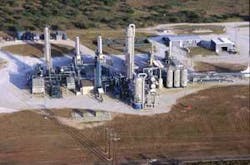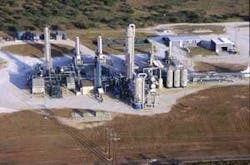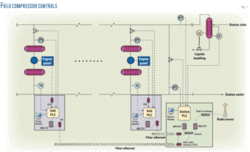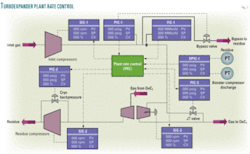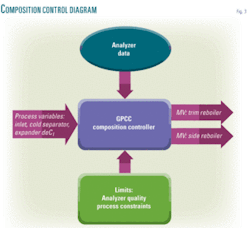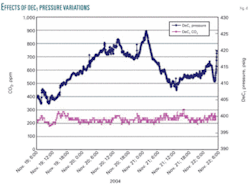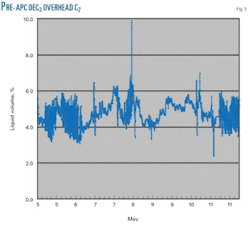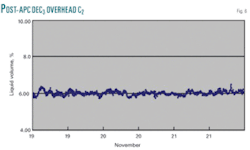Special Report: Practical advanced control helps midstream operations
Although digital control systems—distributed control systems, programmable logic controller, and other automation equipment—are present in practically every process safety management (PSM) facility and in many non-PSM facilities in the midstream oil and gas industry, the use of the automatic control capability in those systems continues to be lower than it could be.
Many issues contribute to the large number of control loops that can be found in manual mode at most facilities, and most control strategies employed in today’s midstream processes simply mimic designs developed for panel-board instruments decades ago. But gaining practical, sustained benefits from this process-control equipment is readily achievable: Typically, little capital investment is required other than initial engineering and commissioning labor.
With a reasonable investment in such basic support as maintenance and training to sustain performance, the effective use of automatic process control can deliver substantial operating benefits over the long term.
Control systems seem to be regarded in many operations as more a necessary evil than a benefit, and the choice of control equipment, the execution of the programming tasks, and the theoretical knowledge of many of the designers of complex controls reflect this attitude.
Even though control systems can have a major impact on operations for good or ill, much more time and energy are spent on the maintenance of rotating machinery and other process equipment run by the control system than on the most essential components of the control system—the engineering and design of the software included in the system that converts it from a collection of parts into a purpose-built system tailored to control a specific facility.
Yet control systems can play just as beneficial a role in successful processing operations as a well-maintained 6,000-hp compressor or a modern cryogenic demethanizer.
Where employed
Automatic control systems are employed in most areas of midstream, including:
- Field compression.
- Gas conditioning (sweetening and dehydration).
- NGL extraction.
- NGL fractionation.
- Heating systems.
Each of these operating areas holds opportunities for achieving benefits from either advance process control (APC) or from enhanced proportional-integral-derivative (PID) controller strategies typically referred to as advanced regulatory control (ARC).
Field compression
Field compressor stations and remote skids used for gathering systems are typically operated as unmanned facilities and frequently can be found operating with limited automatic controls. For many operators, the approach is to check compressor status via a supervisory control and data acquisition system and send someone out when a unit trips. Smaller operations without SCADA may simply perform periodic site visits and restart units found to be tripped.
Several areas of control present the operator with compressor automation opportunities:
- Automatic compressor station upset management for “bumps” caused by liquid slugs and equipment trips. Temporarily reducing inlet volume rates to limit liquid surge rates to the capacity of liquids handling equipment during pigging, new well commissioning, etc. can reduce the number of trips and restarts.
Well-tuned station capacity control strategies with effective overrides can prevent trips due to upstream or downstream unit shutdowns and restarts. - Compressor station capacity control employing strategies that minimize compression ratios per stage, reduce recycle volumes, and manage excess capacity with speed controls and automation of volume pockets and unloaders can improve operations and reduce specific fuel consumption per unit volume compressed.
- Historical data analysis of processed volumes and fuel consumption can be used to bias station rate controls to operate each parallel unit closer to its most efficient operating range to reduce fuel consumption per volume processed.
For single compressor units, an operator can reap dividends by upgrading the unit controller to a PLC or, if already equipped, upgrading the PLC logic to perform automatic capacity control and trip prevention. For multiple unit stations, adding a station controller (either a PLC or a small DCS) to manage common inlet systems and to provide station capacity control for parallel units can be effectively accomplished (Fig. 1).
Gas treating
One of the most common midstream processing operations is gas treating and conditioning. Amine treaters remove CO2 and H2S either in unmanned field systems or units operated at manned facilities. These are typically paired with triethylene glycol (TEG) dehydration units and may be operated in conjunction with refrigerated or Joule Thomson dewpoint control units to remove the heaviest NGLs.
These units typically employ a local PLC that performs all process control and shutdown functions.
Effective automatic control of gas treating can reduce operating costs and improve on-spec performance. Consistent regeneration of amine units by robust control of amine reboilers can help ensure on-spec product. Many conventional units use a still-bottoms temperature controller on the reboiler for simplicity, but this strategy typically yields poor results and frequently results in degraded amine with subsequent foaming, corrosion, and other problems.
Using a constant stripping ratio strategy will yield more consistent results and will avoid overheating amine if proper temperature overrides are included. In dewpoint plants, process chillers typically are operated at less than optimum levels of refrigerant. A strategy that automatically senses whether the tubes are covered is very simple to add and low in cost. Coupled with upset management, which protects against carryover due to sudden loss of load, this kind of simple enhancement can significantly improve capacity, reduce energy, or both.
NGL recovery
In situations where economic quantities of NGLs are to be recovered, enhanced automatic process control strategies present many opportunities for beneficial upgrades. The processes generally employed for NGL recovery include the following:
• Refrigerated NGL recovery plants. Where LPG recovery (C3+) is the objective and either there is little ethane or there is no market for ethane, NGL recovery may be achieved by refrigeration of inlet gas with glycol injection or glycol dehydration to prevent freezing.
As in refrigerated dewpoint control processes, effective control of refrigeration can improve plant performance and reduce horsepower when:
—An enhanced refrigeration load control strategy manages operation to maximize recovery and observe plant constraints, while providing a rapid response to plant upsets and minimizing the potential for liquid carryover.
—Using a simple and inexpensive control strategy to ensure the chiller tubes are always operated at efficient refrigerant levels. Refrigeration horsepower and heat exchanger surface area are used to process the maximum achievable capacity of gas with the most effective temperature control of processed gas.
• Lean oil plants. There are still many refrigerated absorption (lean oil) facilities operating in which additional ethane recovery is insufficient to justify the capital cost of replacement with a turboexpander plant or the gas composition is not well suited for turboexpander processing. Opportunities exist to implement enhanced control strategies at many such plants, including:
—Lean oil/inlet ratio controls to compensate for inlet composition and tower loading. The ratio strategy includes constraints to ensure adequate contactor liquid loading, deethanizer operation performance, and NGL fractionation.
—Refrigeration load management and refrigerant level optimization for chiller efficiency and stable operation.
—Predictive control of de-ethanizer feed composition for enhanced response to load changes and upsets.
—Composition control for the lean oil still for consistent absorber performance and NGL quality control.
—Enhanced steam boiler (where used) firing rate control to stabilize steam-driven equipment operation during upsets and large load start-ups and shutdowns.
• Cryogenic turboexpander plants. Turboexpander plants for deep cut NGL recovery typically operate with a basic control strategy. A pressure controller regulates the expander vanes, while a temperature controller maintains bottoms composition. The majority of these plants do not employ any sort of composition control on the demethanizer, and the processing rate is typically determined either by an operator readjusting the speed of recompressors or, in more automated instances, by a simple pressure controller regulating the speed or recycle valve on the recompressors.
Yet with a small investment, most turboexpander plants can reliably incorporate both demethanizer composition control and enhanced processing rate control in the basic process control system.
Field-proven strategies have been successfully implemented and operated over long periods on cryogenic turboexpander plants, including:
—Turboexpander plant processing rate control. Processing rates are determined by the supply of available inlet gas or by setting of a desired rate for a straddle plant, subject to equipment limits such as demethanizers maximum allowable operating pressure (MAOP) or recompressor differential pressure or rod loading.
Coordinated manipulation of expander vanes and recompressor capacity continuously readjusts conditions in the direction of the highest recovery possible for a given rate and feed composition. This design has been used in single and parallel train sites. This strategy has been operated reliably for up to 15 years at several sites (Fig. 2).
—Demethanizer bottoms composition control (Fig. 3). This strategy continuously corrects tower boil-up based upon changes in bottoms temperature, tower pressure, expander discharge temperature, and other relevant conditions. Paired with rate control to eliminate the need for operator adjustments whenever the demethanizer pressure changes (Fig. 4), it can employ a typical existing multistream analyzer to reduce capital costs.
Analysis data are tested before use each time a sample is received, and this has proven effective in maintaining the strategy in long-term service. Operators are unlikely to return untrustworthy strategies to automatic after repeated failures. This composition control strategy has been in use as long as the rate-management strategy.
—NGL product surge tank level smoothing. This is a simple strategy to allow surge tank levels to “float” within a limited range rather than being held at a fixed set point by a level controller (which eliminates the surge effect) that can be added to any PLC or DCS. This smoothes the flow from the surge tank to fractionation, product treating, or the pipeline, making those units run smoother.
—Expander and recompressor trip management. Rotating machinery trips are typical events in turboexpander plants. Pressure controllers may not be tuned fast enough to catch the resulting pressure excursion, and lifted relief valves or complete shutdown on low recompressor suction pressure may result.
The DCS or PLC can be configured to monitor the status of key rotating equipment and take corrective action much faster than the fastest operator and faster than a traditional PID loop.
—Expander, booster compressor surge and overspeed controls. When expander overspeed shutdowns are an issue, a speed control override has been configured to limit the action of the pressure or flow controller that normally controls the expander vanes. This permits an expander to be operated reliably very close to its maximum speed, allowing full use of its capacity without large safety margins to protect against overspeed.
Similarly, the expander PLC or plant DCS or PLC can readily be programmed to provide surge control on the booster compressor, and this has been successfully implemented at several locations.
NGL fractionation controls
NGL fractionation can benefit greatly from advanced control strategies.
Overpurification is a common practice to provide “cushion” and sometimes just because the equipment is capable of it. Because many fractionators rely solely on temperature controls rather than direct analyzer or model-based controls, changes in feed composition or other disturbances may cause towers to go off spec or result in upsets such as flooding if the operator is otherwise occupied and doesn’t react in time.
Overpurification uses more energy than necessary, may reduce capacity, and most importantly, reduces the yield of higher valued products.
Improved controls reduce variation in product composition due to all causes, permitting operations to move target set points closer to specifications. This generally increases the yield of higher valued products while reducing the energy necessary to separate each barrel of feed (Figs. 5 and 6).
Without use of third-party advanced control software packages, modern distributed control systems can be configured with enhanced NGL fractionation strategies to improve distillation column performance over traditional temperature control with designs that include:
- Model-based composition control.
- Energy balance models to maintain column separation performance.
- Internal material balance control for stable column operation.
- Material balance reflux management for more stable column operation.
- Constraint control-based optimizers to maximize feed rates or reduce energy consumption (Fig. 7).
One common issue, during use of on stream analyzers for closed loop control, is that they are less reliable than most other instrumentation. Because the components are mostly lighter boiling paraffins of varying molecular weight, regressive models developed from historical data work well in making short term (hours to days) predictions of composition based upon column operating conditions.
When automatically corrected with validated on stream analyzer data, composition models are reliable and accurate for advanced control strategies. Performance of automatic tests on the reasonability of new analysis data typically catch analyzer failures before they cause control problems.
And because analyzer samples are used periodically to correct the model rather than in closed-loop control, analyzer failures can usually be corrected without causing composition control problems. Several sites have operated reliably for years with this type of DCS-based control.
Heating system controls
Most gas and NGL treating, recovery, and fractionation plants use some form of heating system, such as steam from boilers and waste-heat boilers or heat-medium circulation from direct-fired heaters and waste-heat recovery units. Because there are usually multiple heat sources in parallel and multiple heat users also in parallel, however, heating systems frequently cause process cycling and upsets.
A disturbance in one tower can cause the heating system to cycle in reaction, thus upsetting all the other heat supply and heat-consuming equipment. Frequently a few flow and temperature controllers are the only automatic controls, with the operator setting a significant amount of excess recycle heat medium flow or waste steam to the deaerator to handle surges in self defense. Without an overall strategy to balance the supply of heating fluid with the demand, each change in supply or demand causes an upset in the other side of the equation.
Although “advanced” control is not typically required here, the arrangement of control loops can make major differences determining whether the heating system is a tool for maintaining stable control or is another contributor to upsets and quality variation in Amine stills, demethanizers, and fractionators. And if properly designed, the control strategy can prevent heat-medium breakdown (a common problem) due to overheating.
It can also be designed to ensure that waste-heat sources are kept at maximum capacity while fired heaters are used only for swing loads to reduce energy consumption. All that is normally required is a few carefully arranged PID loops with effective tuning to maintain a balance between heating fluid supply and demand.
Executing a successful project
Like all successful projects, an advanced control project requires certain steps in its execution to achieve the desired results and to ensure that it delivers long-term benefits. To be successful, an APC project needs:
- Clear objectives (scope).
- Adequate resources in terms of instrumentation and DCS or PLC equipment as well as skilled personnel for implementation.
- Committed management support.
- Proper precommissioning preparation.
- Effective commissioning.
- Thorough operator training.
- Monitoring tools (“dashboards”) to verify effective use.
- Periodic maintenance and operator refresher training.
APC projects are typically initiated based either upon a process study that has determined that the achievable benefits justify the investment and are sustainable or upon the need to manage a known performance issue such as product specifications in which the cause of off-specification product has been determined to be control-related.
Example ‘dashboard’ indicators
- For all APC/ARC strategies:<
- % time in automatic for previous 30 days (or other interval).
- Number of times placed in manual for previous 30 days (or other interval).
- Number of analyzer or other instrument failure alarms previous 30 days (or other interval).
- For compressor control performance:
- Average compression ratio each stage.
- Specific fuel consumption, btu/hp-hr.
- Fuel consumption, btu/MMscf of throughput.
- For plant control performance:
- Number off-spec events for previous 30 days (or other interval).
- Average C1/C2 ratio.
- Average recovery of C3+.
- Average btu/bbl of NGL.
- Average volume processed.
The first step is to survey available information, control system capacity, operator familiarity with advanced controls and with the process, and condition of instrumentation and control devices such as valves. Of particular significance is the condition of any on stream analyzers and the maintenance support that is available to deal with any issues that may be identified with the quality of on stream analysis.
Although APC and ARC controls can be engineered to be reliable during analyzer failures, on stream analyzers must provide accurate data when they are functioning correctly. Lack of skilled analyzer support staff will severely impair the ability to execute a successful APC project.
Another important step in building a successful APC project is in the testing, repairing, and tuning of the basic control loops that already exist in the plant or that will be added to support the APC or ARC strategy. Many of the benefits of an advanced control project accrue from this first step, and it is an important one, whether the project is to implement a DCS-based APC/ARC upgrade or to install advanced multivariable control software for a complex process.
Too much focus on the advanced aspects of the project can result in missed opportunities to gain improved control benefits by ensuring that all instruments and valves are working properly and all major loops are controlling as well as possible at the lowest level.
Commissioning is another major step. It is important to stress test the APC/ARC strategy under real-world conditions. All constraints and alarms should be verified, and any special event logic or override loops should be triggered or forced into action to verify stability.
Operator familiarization and training may be the single most important aspect of an APC/ARC project. If any of the operators lack confidence or familiarity with the use of and expected behavior of the controls, additional training and “go-by” documentation needs to be provided. If the APC/ARC controls at times make process changes that are counter intuitive or go against prevailing beliefs about how the process should be operated, their performance needs to be demonstrated to each operator until the confidence to trust the controls is developed.
It is also true that operators are often aware of equipment constraints or process events that are infrequent enough that the APC/ARC engineer may be unaware of them. Having all the operators undergo first-hand controller operation in training (as opposed to classroom training) can provide additional design feedback that can be used to make the strategy more reliable. Make no bones about it: Reliability is a primary requirement of a successful APC/ARC strategy.
To ensure that the strategies are used by operations and to provide management and maintenance with adequate feedback about the successful operation of the controls, each project should include automatic reporting and the configuration of a display “dashboard” that provides readily understood performance measurements, or key performance indicators (KPIs). An accompanying box presents an example of “dashboard” indicators.
Finally, to provide sustained performance and true justification for investment, the successful APC/ARC project must include adequate documentation to permit the operating staff to perform routine troubleshooting and maintenance. It is also important to incorporate periodic site visits of a few days or remote PC access by APC/ARC support engineers to verify tuning, address issues that have arisen, and perform refresher training for previous and replacement operators. The periodic site visits should be scheduled at least annually, if not more often. This continued investment will be a small cost compared with the annual returns the APC/ARC strategies typically achieve.
The author
Barry D. Payne ([email protected]) is president of Barry D. Payne & Associates Inc., Stafford, Tex. He has worked in process control design and applications for more than 25 years and has specialized in midstream control applications since 1992. Before founding Barry D. Payne & Associates in 1993, he worked as an independent consultant for 10 years after spending the first 10 years of his career as a research and controls engineer for Dow Chemical Co. Payne holds an MChE from Rice University and is a registered professional engineer in Texas.
